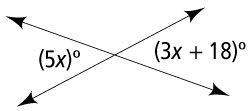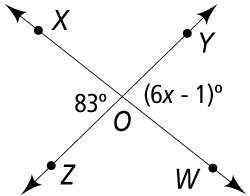Look for a pattern. What are the next two terms in the sequence?
55, 44, 33, 22, ...
11, 0
p -> q
Conditional Statement
If the hypothesis of a true conditional is true, then the conclusion is true.
Law of Detachment
a = a
Reflexive Property of Equality.
Solve for X.
x = 9
A conclusion you reach using inductive reasoning.
Conjecture
q -> p
Converse
Allows you to state a conclusion from two true conditional statements when the conclusion of one statement is the hypothesis of the other statement.
Law of Syllogism
If ∠A ≅ ∠B, then ∠B ≅ ∠A.
Symmetric Property of Congruence.
Solve for x.
x = 14.
An example that shows that a conjecture is incorrect.
Counterexample
~p -> ~ q
Inverse
The process of reasoning logically from given facts to reach a conclusion.
Deductive Reasoning
If a = b and b = c, then a = c.
Transitive Property of Equality.
Two angles that add to 90 degrees
Complementary Angles
Equivalent Truth Values
Converse and Inverse
~q -> ~p
Contrapositive
What can you conclude from the given information? If Karl runs 1 mi, then he runs 1760 yd. If Karl runs 1760 yd, then he runs 5280 ft.
If Karl runs 1 mi, then he runs 5280 ft.
Used to justify equal numbers.
Properties of equality.
Two angles that sum to 180 degrees.
Supplementary Angles
Three components of a good definition.
Clearly understood terms, Precise, Reversible
A single true statement that combines a true conditional and its true converse. Uses the phrase, “if and only if.”
Biconditional
What can you conclude from the given true statement? If you want to buy the school lunch today, then you will need $2.50. You brought $2.50 to school today.
No Conclusion.
Used to justify congruent geometric figures.
Properties of Congruence.
Pairs of opposite angles made by two intersecting lines.
Vertical Angles

